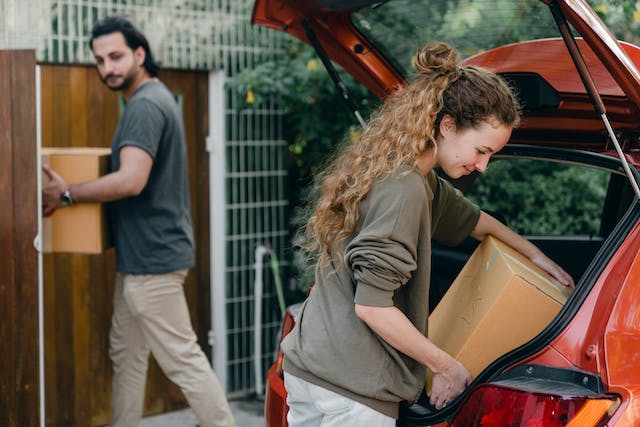Initial Moving Preparations
Embarking on a move requires thoughtful planning and organization. By focusing on these early steps, you’ll ensure a smoother transition to your new home.
Create a Moving Checklist
To remain organized, start by creating a moving checklist. This checklist acts as your roadmap for the move and should include all the critical tasks, from sourcing packing supplies to setting up utilities at your new address. Ensure this list is readily accessible, perhaps in a dedicated moving binder or digital document.
Set a Moving Budget
Next, establish a moving budget. Itemize anticipated expenses such as moving company fees, packing materials, and any travel costs. Keep track of quotes and receipts in your moving binder or a spreadsheet to avoid overspending.
Choose a Moving Date
Selecting a moving date is crucial and can impact the cost and ease of your move. If possible, aim for mid-week or mid-month dates when professional movers may offer better rates due to lower demand.
Inventory Your Belongings
Take stock of your belongings by doing a detailed inventory. This helps you determine what to keep, donate, or discard, and ensures nothing is forgotten. Use a digital tool or a notepad, documenting each item and its condition.
Research Moving Companies
Invest time in researching reputable moving companies. Prioritize professional movers with positive customer reviews. Visit each company’s website and request quotes to compare services. Remember to validate their licenses and insurance for your protection.
Sorting and Decluttering
Before you begin packing for your move, it’s crucial to sort through your possessions. Decluttering can significantly reduce the volume of items you need to transport, saving you time and money.
Sort Items by Category
Firstly, target different areas of your home and sort items into categories such as tools, yard equipment, furniture, and personal items. This methodical approach allows you to see what you have and identify duplicates or unneeded items. Make sure to create separate piles or use boxes labeled:
- Keep: Items you will take to your new home.
- Sell/Donate: Items in good condition that you no longer need.
- Discard: Items that are no longer functional or needed.
Sell, Donate, or Discard Unneeded Items
After sorting, decide which items to sell, which to donate, and which to discard. If an item hasn’t been used in a long time and you can replace it for under $20 or within 20 minutes, consider letting it go. Here’s how to handle each category:
Sell:
- List furniture, electronics, and quality clothing on online marketplaces.
- Use apps specifically designed for selling used items.
Donate:
- Take clothing and household items to local charity shops.
- Offer books to libraries or schools.
Discard:
- Properly dispose of broken or irreparable items.
- Recycle what you can to minimize waste.
Organize a Yard or Garage Sale
If you have a significant number of items to sell, organizing a yard or garage sale can be effective. Advertise your sale in local community boards and social media to draw in a good crowd. Clearly price your items, and be prepared to negotiate. The goal is to let go of as many unneeded possessions as possible while making some money to help with moving expenses.
Acquiring Packing Supplies
When you’re gearing up for a move, getting your packing supplies in order is crucial. You’ll need a range of items to keep your belongings secure and to make unpacking easier at your new home.
Gather Necessary Packing Materials
Your first step is to compile all the packing materials you will need. Start with different sizes of moving boxes—small, medium, large, and specialized types for items like wardrobe and dishes. Don’t forget to include packing tape for sealing boxes and a permanent marker for labeling. To cut costs, seek out free moving boxes from local stores or friends who have recently moved.
- Boxes: Small, Medium, Large, Specialized
- Tape: Packing Tape, Duct Tape
- Markers: Permanent, Waterproof
- Seek free moving boxes from local businesses or online marketplaces.
Label Moving Boxes Clearly
Once you have your materials, it’s time to organize. Label each box with its contents and the room it’s destined for in your new place. This step will save you time and frustration when unpacking. Use a bold, black marker for clarity and consider color-coding labels for different rooms.
- Label by Room: Kitchen, Bedroom, Bathroom, etc.
- Specify Contents: Dishes, Books, Linens
- Use bold writing or color-coded stickers for easy identification.
Protect Valuables with Bubble Wrap
Your valuables need extra care. Wrap items like glasses, paintings, and electronics in bubble wrap to cushion them during the move. It’s also a good idea to use old newspapers and towels for additional padding. Place heavier items at the bottom of the boxes and lighter ones on top, ensuring nothing heavy is packed with delicate items.
- Bubble Wrap: Glasses, Vases, Electronics
- Padding: Newspapers, Towels, Foam
- Pack Wisely: Heavy items on the bottom, lighter on top
Addressing Administrative Tasks
In the whirlwind of packing and planning your move, don’t overlook the administrative tasks that are crucial for a seamless transition. From updating addresses to transferring records, these steps ensure your life continues without hiccups in your new home.
Update Your Address and Subscriptions
Checklist for Address Change:
- Notify the post office to forward your mail.
- Change the address for subscriptions and services.
- Update voter registration to stay eligible for elections.
Remember to revise your contact information for online shopping platforms, magazines, and membership clubs you’re part of. This prevents any interruption in service and ensures you continue receiving your mail at your new location.
Transfer School and Medical Records
It’s important to ensure your school records and medical records are transferred to your new location. Here’s how you can do it:
- Contact your child’s current school to request a transfer of records to the new school.
- Reach out to your healthcare providers to have your medical history forwarded to new healthcare professionals.
These steps are essential to maintain the continuity of education and healthcare services without any inconvenience or delay.
Handle Utilities and Insurance Transfers
Managing your utilities and insurance coverage is a key step in the moving process. Here’s what you need to cover:
Utilities:
- Contact your current utility providers (electricity, gas, water, internet) to schedule disconnection.
- Set up services at your new address to start on your move-in day.
Insurance:
- Inform your home and auto insurance providers of your move.
- Review and adjust your insurance coverage if necessary, based on the specifics of your new home and location.
Taking care of these administrative “to-dos” in advance will help make your move a lot smoother and eliminate potential stressors once you’ve relocated.
Packing and Organizing
When you’re getting ready to move, careful packing and organizing are crucial for a smooth transition. By following a structured timeline and preparing essential boxes specifically for your first night and sensitive documents, you’ll set the stage for a hassle-free move.
Follow a Packing Timeline
Start by creating a detailed packing schedule and stick to it. Kick off the process with items you use less frequently, and gradually move to everyday items as moving day approaches. Here’s a quick guide to help you stay on track:
- 8 weeks out: Begin sorting through your belongings. Decide what to keep, sell, donate, or discard.
- 6 weeks out: Start gathering packing supplies like boxes, packing tape, bubble wrap, and labels.
- 4 weeks out: Begin packing non-essential items such as books, decorative pieces, and out-of-season clothing.
- 2 weeks out: Pack up the majority of your belongings, leaving out only the essentials needed for the next two weeks.
- Final week: Confirm everything’s packed, except your daily necessities and first night box.
Prepare an Essentials Box for the First Night
Pack an essentials box that includes items you’ll need for the first 24 hours in your new home. It should be clearly labeled and easy to access. Include items like toiletries, a change of clothes, medications, basic tools, and snacks. Think about what you’ll need to relax and get a good night’s sleep after a long day of moving.
- Toiletries: Toothbrush, toothpaste, soap, shampoo, and towels.
- Clothes: PJ’s, change of clothes for the next day.
- Basic needs: Toilet paper, light bulbs, charging cables, and a small toolkit.
Use Suitcases for Personal Documents
Important documents should get special attention during your move. Use suitcases or a portable file box to keep your documents secure and with you at all times. Organizing your personal documents such as birth certificates, passports, financial records, and insurance policies in one place makes it easy to locate them during and after your move.
- Personal documents: Passports, driver’s licenses, Social Security cards.
- Financial and legal records: Bank statements, tax returns, and property deeds.
- Essential contact information: Keep a list of important contacts, like your moving company and utilities.
Remember to handle these items personally on moving day – don’t leave them with the movers. Your peace of mind is worth the added responsibility.
Final Moving Arrangements
When it comes to moving, locking in your final arrangements is crucial to ensure everything goes smoothly. Here’s how to finalize transportation, movers, and moving day details.
Plan Transportation and Moving Truck Rental
Before your move, decide on transportation. If you’re doing a DIY move, you’ll need to rent a moving truck. Research and compare different rental companies for the best rates and suitable vehicle sizes. Make sure to reserve your truck well in advance, as availability can be limited, especially during peak moving seasons.
How to rent a moving truck:
- Determine truck size: Check moving truck size guides to match your inventory.
- Compare quotes: Look at several rental companies for the best price.
- Confirm rental details: Book your truck rental for the pickup and return dates.
Schedule Professional Movers or Request Help
If you’re not going the DIY route, scheduling professional movers is key. Booking at least a month in advance could save you from last-minute scrambling. For a smoother process, verify that the professional movers are reputable and offer insurance for your belongings during transit. If relying on friends, request time off from work and confirm their availability.
- Choosing movers:
- Check reviews and ratings.
- Confirm licensing and insurance.
- Discuss rates, including any extra charges for heavy items.
- Organizing help:
- Ask friends and family early.
- Prepare a thank-you meal or gift.
Confirm Moving Day Details with All Parties
In the final weeks before your move, confirm all details related to your relocation. Ensure that your moving company or rental agency has all the necessary information, such as dates, times, and locations for loading and unloading. Likewise, touch base with anyone who has offered to help with your move to reiterate the schedule.
- Checklist for confirmation:
- Moving Company: Date, time, address, and services confirmed.
- Rental Agency: Pickup and return times set for the moving truck.
- Friends/Family: Reminders sent out with specific roles and times.




